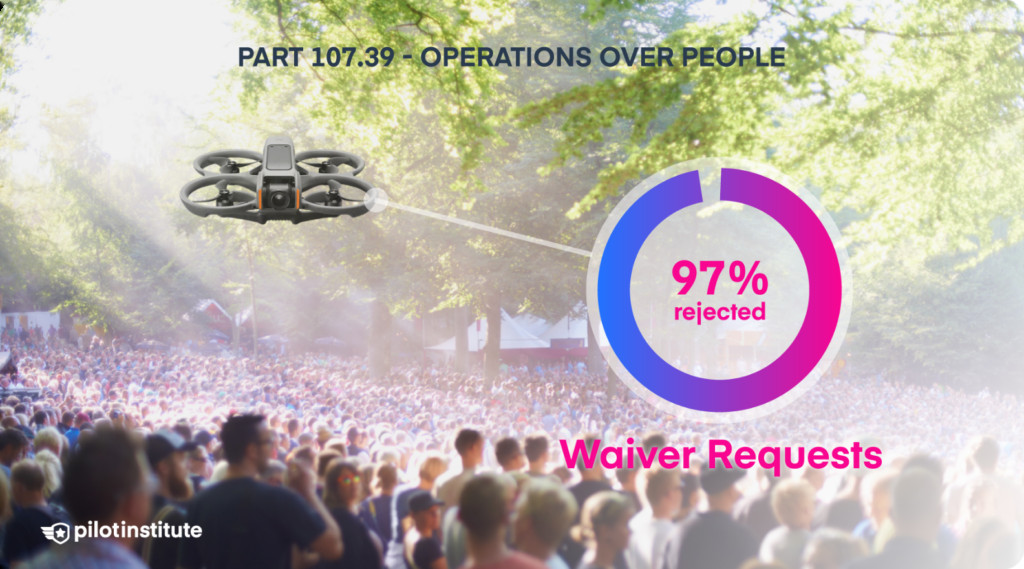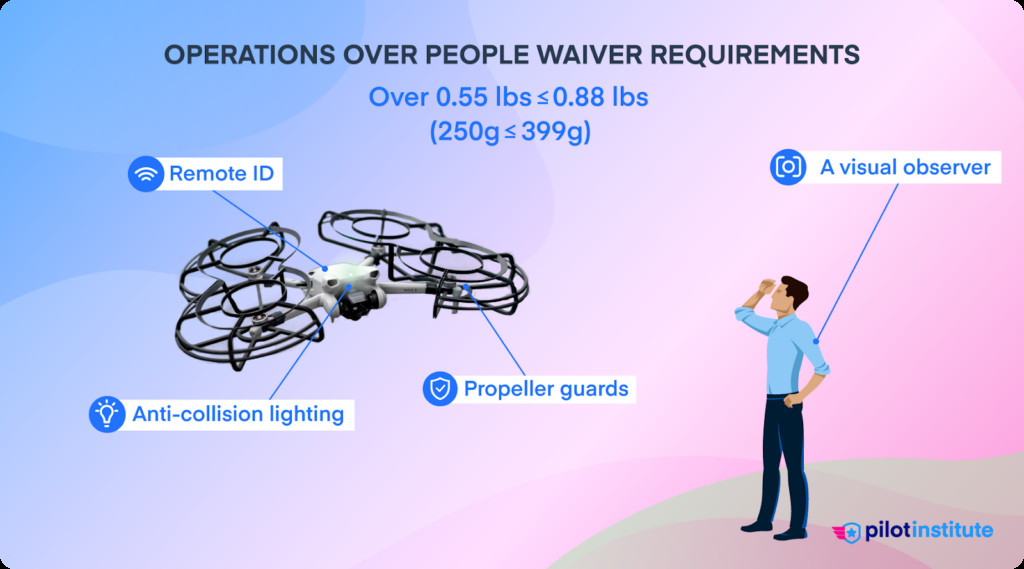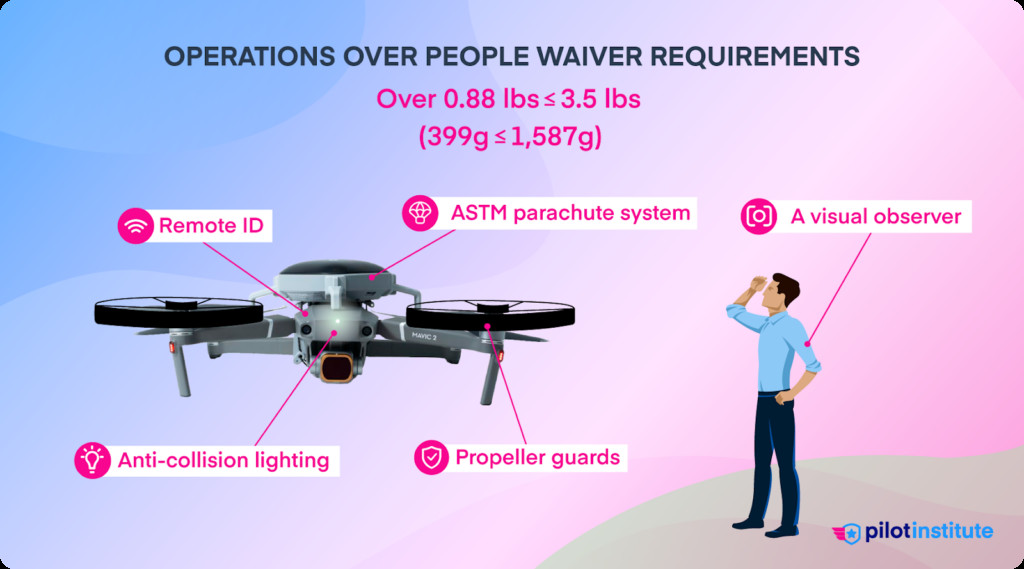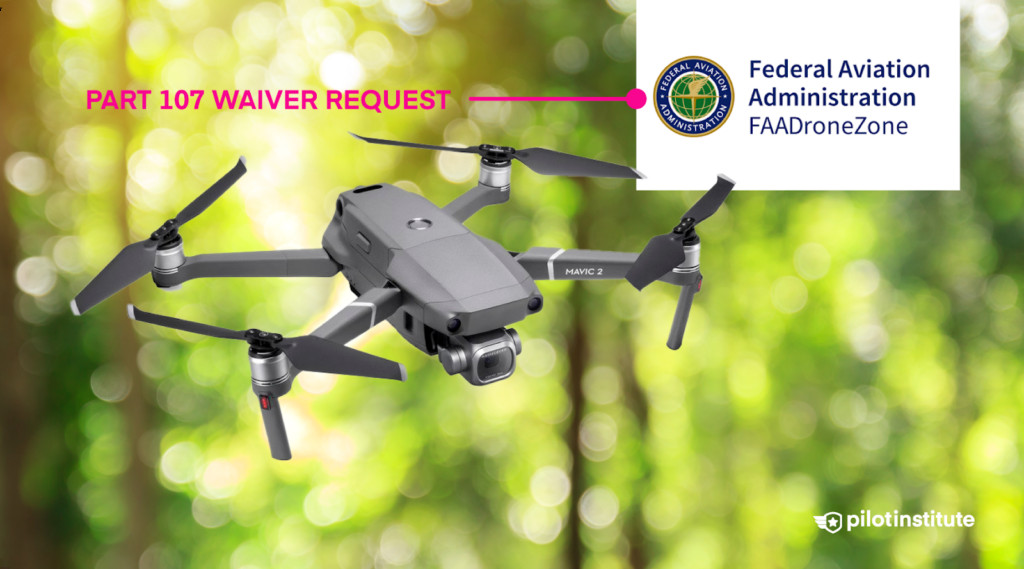Can You Fly A Drone Over People? The short answer is yes, it’s becoming more feasible, but with caveats! The FAA is adjusting regulations, making it easier to obtain waivers for Unmanned Aircraft System (UAS) operations over people, provided you meet specific safety requirements tied to the drone’s weight. For deeper insights into drone regulations, pilot training, and the latest aviation news, explore flyermedia.net, your comprehensive resource for all things aviation. Stay informed about FAA regulations, aviation safety, and commercial drone operations.
Table of Contents
- Understanding the Old Rule: Why Waivers Were Difficult to Obtain
- What Are the New Rules for Flying Drones Over People?
- 2.1 Drones Weighing Between 0.55 Lbs and 0.88 Lbs
- 2.2 Drones Weighing Between 0.88 Lbs and 3.5 Lbs
- How to Properly Submit a Waiver Request to the FAA
- Drone Categories and Their Impact on Flying Over People
- Conclusion: Embracing Safer Skies with Updated FAA Regulations
- FAQ: Your Questions About Flying Drones Over People Answered
1. Understanding the Old Rule: Why Waivers Were Difficult to Obtain
Previously, flying a drone over people was largely restricted under standard Part 107 rules, specifically regulation 107.39. While waivers were theoretically available, they faced a high rejection rate, approximately 97%. This made it challenging for commercial drone pilots to legally conduct operations over populated areas. The FAA’s strict stance made operations over people nearly impossible, regardless of the use case. The agency has made it somewhat easier with the introduction of categorized drones, but some of the operational limits of this system are still too strict to make them practical for commercial operations. The high rejection rate highlighted the ineffectiveness of the waiver provision.
 Drone flying over a crowd, illustrating the challenge of obtaining OOP waivers, with a chart showing a high rejection rate.
Drone flying over a crowd, illustrating the challenge of obtaining OOP waivers, with a chart showing a high rejection rate.
2. What Are the New Rules for Flying Drones Over People?
The FAA has listened to feedback and relaxed waiver requirements for operations over people. It’s crucial to understand that the core regulation hasn’t changed; a waiver is still necessary. The key difference lies in the streamlined requirements for obtaining this waiver. The rules are now categorized by the UAS weight. These new rules pave the way for expanded drone operations in various sectors, from infrastructure inspection to aerial photography, all while maintaining a focus on public safety. The agency wants to ensure accountability and responsibility with UAS operations, providing some clarity and opportunities for commercial operators.
2.1 Drones Weighing Between 0.55 Lbs and 0.88 Lbs
For drones weighing over 0.55 lbs (250 grams) but less than or equal to 0.88 lbs (399 grams), the requirements include:
- Propeller guards
- Anti-collision lighting
- Remote ID
- A visual observer
Meeting these requirements significantly increases the likelihood of waiver approval. Drones in this weight category include popular models like DJI Mini drones, Autel Nano, Parrot Anafi, and DJI Avata 2. The waiver request is very likely to get approved as long as you comply with the requirements stated above.
 New FAA waiver requirements for drone operations over people for UAS weighing between 0.55 lbs and 0.88 lbs, including propeller guards, anti-collision lighting, Remote ID, and a visual observer.
New FAA waiver requirements for drone operations over people for UAS weighing between 0.55 lbs and 0.88 lbs, including propeller guards, anti-collision lighting, Remote ID, and a visual observer.
2.2 Drones Weighing Between 0.88 Lbs and 3.5 Lbs
For drones weighing over 0.88 lbs (399 grams) but less than 3.5 lbs (1587 grams), the requirements are:
- Propeller guards
- Anti-collision lighting
- Remote ID
- A visual observer
- An ASTM parachute system
Complying with these requirements significantly boosts the chances of waiver approval. Popular drones in this category include DJI Air Series, DJI Mavic Series, Autel Lite and Evo 2 Series, Parrot Anafi AI, Skydio 2 and X2, Phantom 4 Pro V2, DJI FPV, and Avata 1. Having these requirements when you submit a waiver request makes it very likely that you will be granted the waiver.
 Overview of new FAA requirements for drone operations over people for drones weighing between 0.88 lbs and 3.5 lbs, showing propeller guards, anti-collision lighting, Remote ID, visual observer, and an ASTM parachute system.
Overview of new FAA requirements for drone operations over people for drones weighing between 0.88 lbs and 3.5 lbs, showing propeller guards, anti-collision lighting, Remote ID, visual observer, and an ASTM parachute system.
3. How to Properly Submit a Waiver Request to the FAA
Waiver requests are submitted through the FAA DroneZone website. The FAA provides detailed documentation to guide you through the process. Ensure you answer all questions thoroughly and avoid cutting corners, even though the process is now simpler. It’s imperative to get the waiver to comply with FAA regulations.
 Drone with overlay text emphasizing that waiver requests should be submitted via the FAA DroneZone website, highlighting the importance of compliance and the resources available.
Drone with overlay text emphasizing that waiver requests should be submitted via the FAA DroneZone website, highlighting the importance of compliance and the resources available.
4. Drone Categories and Their Impact on Flying Over People
The FAA established rules for flying UAS over people based on weight categories prior to these recent changes. These rules impose specific restrictions based on a drone’s category. Currently, most FAA-approved drones fall under Category 1 (weighing 0.55 lbs or less), which requires propeller guards. This limits the selection of drones suitable for commercial work. As of now, only one UAS has been approved under Category 3 (the senseFly eBee), and none have been approved under Categories 2 and 4.
 Overview of OOP drone categories, including requirements and privileges, indicating how weight categories impact the ability to conduct operations over people under FAA regulations.
Overview of OOP drone categories, including requirements and privileges, indicating how weight categories impact the ability to conduct operations over people under FAA regulations.
5. Conclusion: Embracing Safer Skies with Updated FAA Regulations
The FAA’s decision to relax OOP waiver rules reflects a recognition of the safety advancements in drone technology. While the underlying rule on OOP remains, the FAA has simplified the waiver process. This shift underscores the importance of safety in UAS operations, requiring investments in hardware like parachutes and propeller guards. Complying with these requirements minimizes accident risks and potential damage, enabling safer and more versatile drone operations.
For the latest insights, visit flyermedia.net, where you’ll find comprehensive resources on drone regulations, pilot training programs, and cutting-edge aviation news. Whether you’re a seasoned aviator or just starting your journey, flyermedia.net is your go-to source for navigating the evolving landscape of aviation. Stay connected with us and elevate your understanding of the skies.
6. FAQ: Your Questions About Flying Drones Over People Answered
-
Can I fly my drone over people without a waiver?
No, generally, you cannot fly your drone over people without a waiver unless your drone meets the requirements of the FAA’s Part 107 rules for operations over people, which typically involve very small, lightweight drones. -
What is the FAA’s Part 107 rule regarding flying over people?
Part 107.39 of the FAA regulations prohibits flying a small UAS over people unless you have a waiver or the drone meets specific criteria related to weight and operation. -
What are the requirements for obtaining a waiver to fly a drone over people?
The requirements depend on the weight of your drone. For drones between 0.55 lbs and 0.88 lbs, you need propeller guards, anti-collision lighting, Remote ID, and a visual observer. For drones between 0.88 lbs and 3.5 lbs, you need all the above plus an ASTM parachute system. -
How do I submit a waiver request to the FAA?
You can submit a waiver request through the FAA DroneZone website. Ensure you provide all the required information and documentation. -
What types of drones are more likely to be approved for operations over people?
Drones that are lightweight and equipped with safety features like propeller guards and parachute systems are more likely to be approved. -
What are the weight categories for drones regarding operations over people?
The FAA categorizes drones based on weight: under 0.55 lbs, between 0.55 lbs and 0.88 lbs, and between 0.88 lbs and 3.5 lbs. Each category has different requirements for waivers. -
What safety measures are required to fly a drone over people?
Required safety measures include propeller guards, anti-collision lighting, Remote ID, a visual observer, and, for heavier drones, an ASTM parachute system. -
Are there any drones that are pre-approved for flying over people?
Currently, only a few drones meet the FAA’s criteria for flying over people without a waiver, typically very small and lightweight models. -
What should I do if my waiver request is rejected?
Review the reasons for rejection and address any deficiencies in your application. You may need to provide additional documentation or safety measures. -
Where can I find more information about drone regulations and waivers?
Visit the FAA DroneZone website and flyermedia.net for detailed information, guidance, and the latest news on drone regulations and operations.
The FAA’s evolving regulations aim to strike a balance between enabling innovative drone operations and ensuring public safety. Understanding these rules is crucial for any drone operator looking to expand their capabilities while remaining compliant. Always refer to the latest FAA guidelines and resources for the most accurate and up-to-date information. At flyermedia.net, we keep you informed with the latest aviation news, training programs, and industry insights. Explore our website and unlock your potential in the world of aviation.
Ready to take your drone operations to the next level? Visit flyermedia.net today for comprehensive resources, expert advice, and the latest updates on FAA regulations. Discover training programs, explore career opportunities, and stay informed with our aviation news coverage. Fly higher with flyermedia.net! Address: 600 S Clyde Morris Blvd, Daytona Beach, FL 32114, United States. Phone: +1 (386) 226-6000. Website: flyermedia.net.
